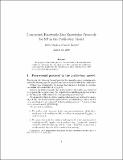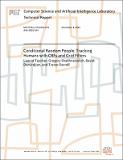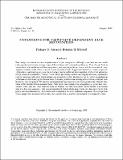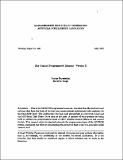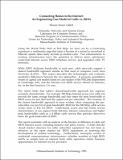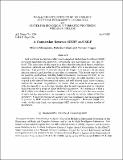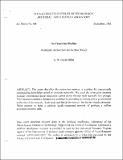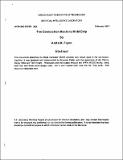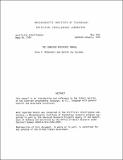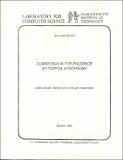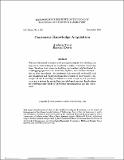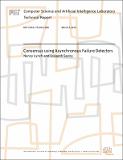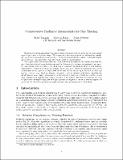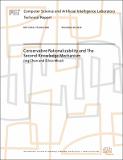Browsing Computer Science and Artificial Intelligence Lab (CSAIL) by Title
Now showing items 685-704 of 3804
-
Concurrent Timestamping Made Simple
(1992-09)Concurrent Timestamp Systems (CTSS) allow processes to temporally order concurrent events in an asynchronous shared memory system. Bounded memory constructions of a CTSS are extremely powerful tools for concurrency control, ... -
Concurrent/Resettable Zero-Knowledge Protocols for NP in the Public Key Model
(2000-08)We propose a four-round protocol for concurrent and resettable zero-knowledge arguments for any langauge in NP, assuming the verifier has a pre-registered public-key. We also propose a three-round protocol with an additional ... -
Conditional Random People: Tracking Humans with CRFs and Grid Filters
(2005-12-01)We describe a state-space tracking approach based on a Conditional Random Field(CRF) model, where the observation potentials are \emph{learned} from data. Wefind functions that embed both state and observation into a space ... -
Conditions for Viewpoint Dependent Face Recognition
(1993-08-01)Poggio and Vetter (1992) showed that learning one view of a bilaterally symmetric object could be sufficient for its recognition, if this view allows the computation of a symmetric, "virtual," view. Faces are roughly ... -
The Condor Programmer's Manual - Version II
(MIT Artificial Intelligence Laboratory, 1987-07)This is the CONDOR programmer's manual, that describes the hardware and software that form the basis of the real-time computational architecture built originally for the Utah-MIT hand. The architecture has been used ... -
Configuration Space Control
(1977-12-01)Complicated systems with non-linear time-varying behavior are difficult to control using classical linear feedback methods applied separately to individual degrees of freedom. At the present, mechanical manipulators, ... -
Congestion Control in Routing Networks
(1986-10)Multistage routing networks present an attractive cost-effective method of interconnection for medium to large scale multiprocessors. Recent results concerning performance degradation in the presence of "hot spots" have ... -
Connecting Homes to the Internet: An Engineering Cost Model of Cable vs. ISDN
(1995-06)Using the World Wide Web at 28.8 Kbps (or less) can be a frustrating experience: a multimedia page that takes a fraction of a second to download at Ethernet speeds takes many seconds at modem rates. Two enhancements to ... -
A Connection Between GRBF and MLP
(1992-04-01)Both multilayer perceptrons (MLP) and Generalized Radial Basis Functions (GRBF) have good approximation properties, theoretically and experimentally. Are they related? The main point of this paper is to show that for ... -
The Connection Machine
(1981-09-01)This paper describes the connection memory, a machine for concurrently manipulating knowledge stored in semantic networks. We need the connection memory because conventional serial computers cannot move through such networks ... -
The Connection Machine RAM Chip
(MIT Artificial Intelligence Laboratory, 1983-01-03)This document describes the three transistor NMOS dynamic ram circuit used in the connection machine. It was designed and implemented by Brewster Kahle, with the assistance of Jim Cherry, Danny Hillis and Tom Knight. ... -
The Conniver Reference Manual
(1972-05-01)This manual is intended to be a guide to the philosophy and use of the programming language CONNIVER, which is "complete," and running at the AI Lab now. It assumes good knowledge of LISP, but no knowledge of Micro-Planner, ... -
The Conniver Reference Manual
(1972-05-01)This manual is an introduction and reference to the latest version of the Conniver programming language, an AI language wit general control and data-base structures. -
CONS
(MIT Artificial Intelligence Laboratory, 1974-11) -
Consensus in the Presence of Partial Synchrony
(1985-10)The concept of partial synchrony in a distributed system is introduced. Partial synchrony lies between the cases of a synchronous system and an asynchronous system. In a synchronous system, there is a known fixed upper ... -
Consensus Knowledge Acquisition
(1989-12-01)We have developed a method and prototype program for assisting two experts in their attempts to construct a single, consensus knowledge base. We show that consensus building can be effectively facilitated by a debugging ... -
Consensus using Asynchronous Failure Detectors
(2015-03-02)The FLP result shows that crash-tolerant consensus is impossible to solve in asynchronous systems, and several solutions have been proposed for crash-tolerant consensus under alternative (stronger) models. One popular ... -
Conservative Logic
(1981-05)Conservative logic is a comprehensive model of computation which explicitly reflects a number of fundamental principles of physics, such as the reversibility of the dynamical laws and the conservation of certain additive ... -
Conservative Radiance Interpolants for Ray Tracing
(1996-04)Classical ray-tracing algorithms compute radiance returning to the eye along one or more sample rays through each pixel of an image. The output of a ray-tracing algorithm, although potentially photorealistic, is a ... -
Conservative Rationalizability and The Second-Knowledge Mechanism
(2010-12-20)In mechanism design, the traditional way of modeling the players' incomplete information about their opponents is "assuming a Bayesian." This assumption, however, is very strong and does not hold in many real applications. ...


